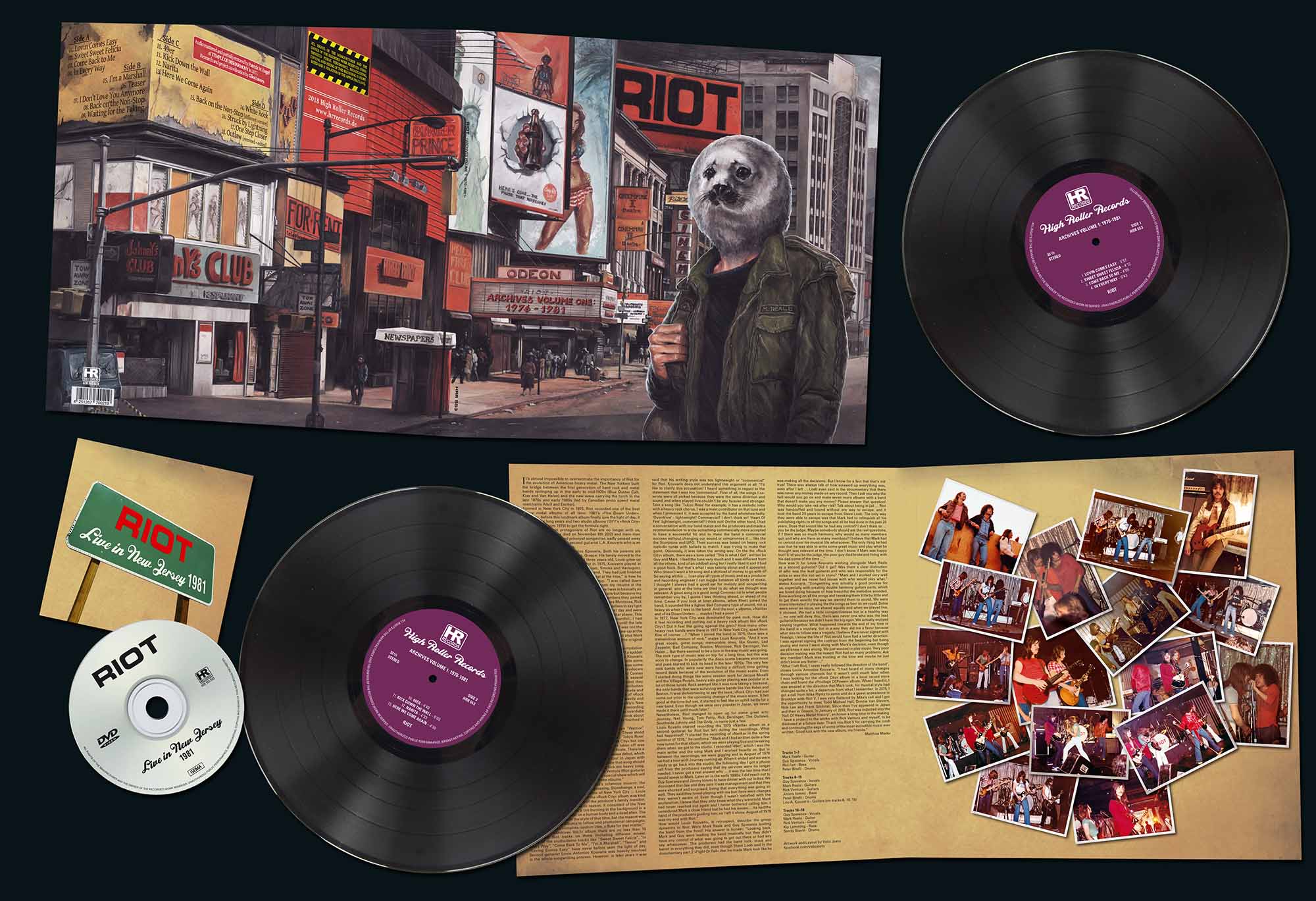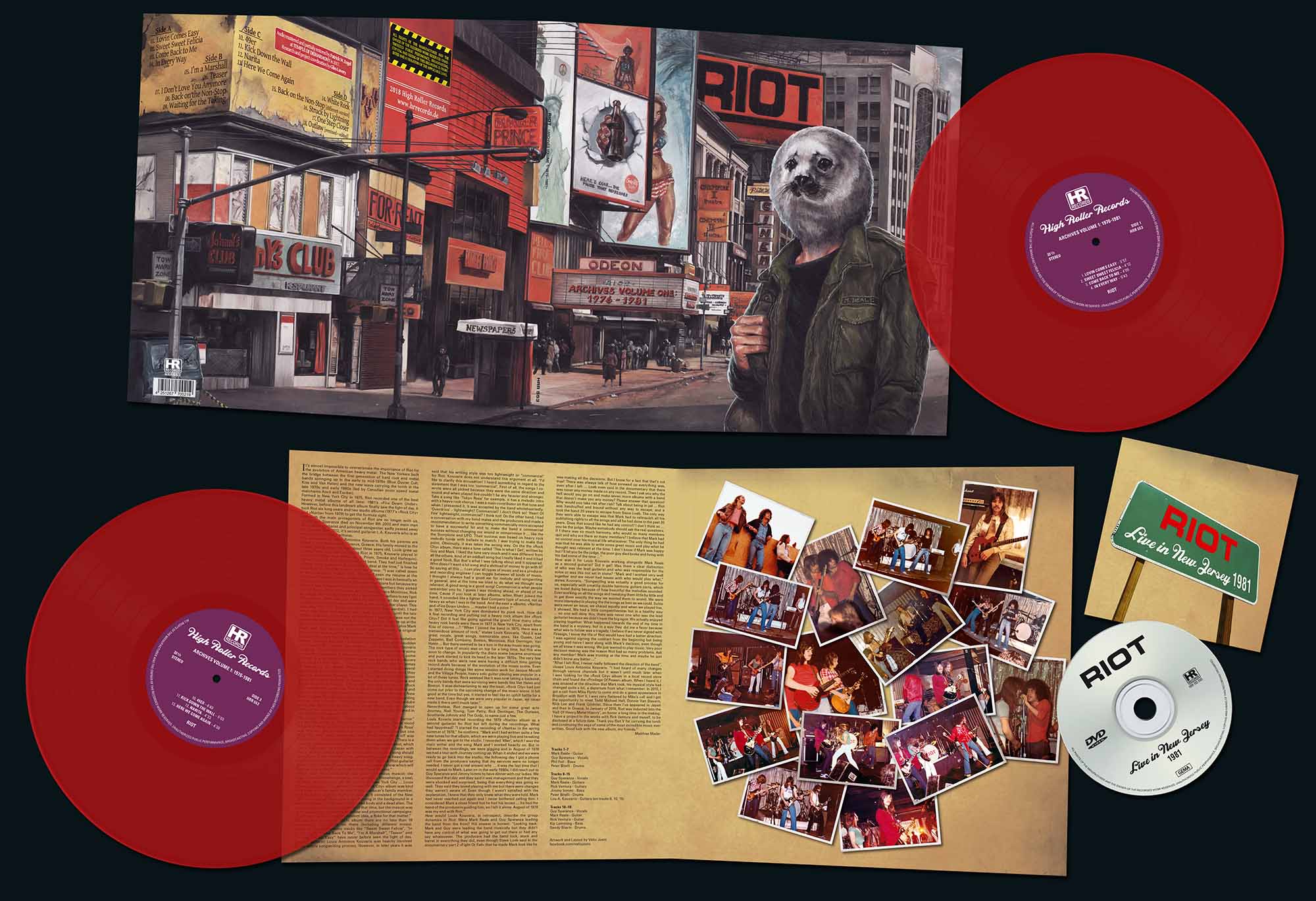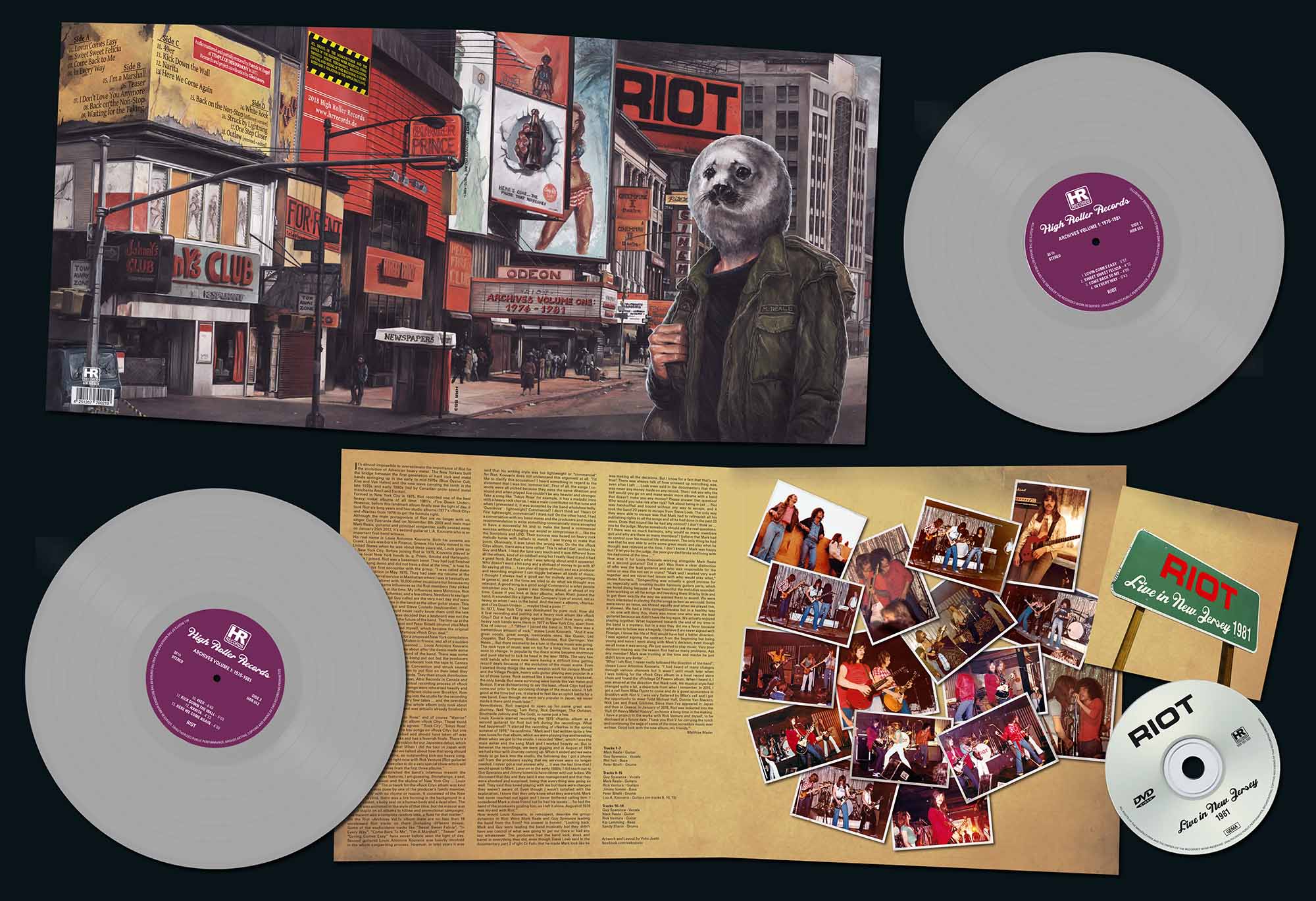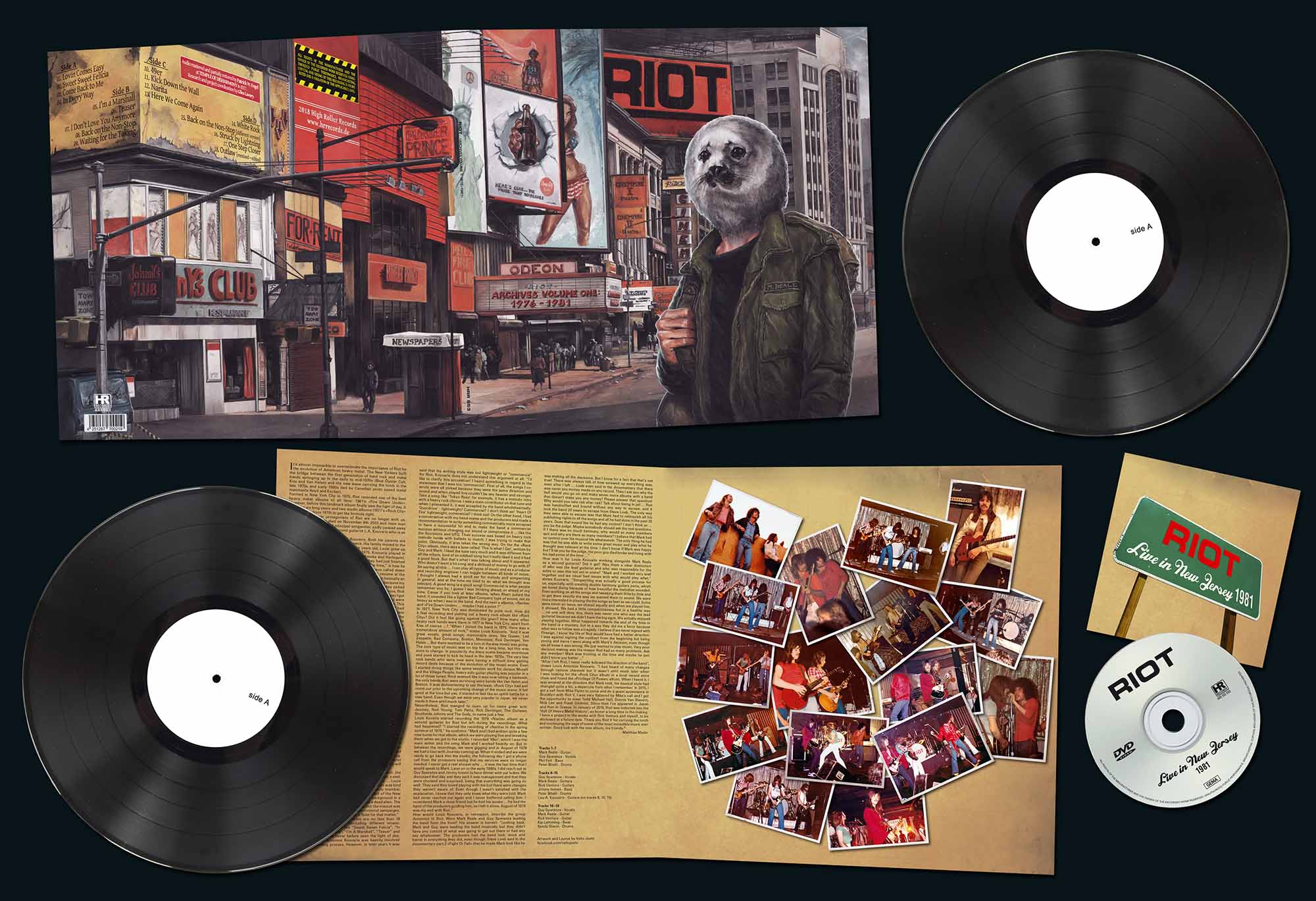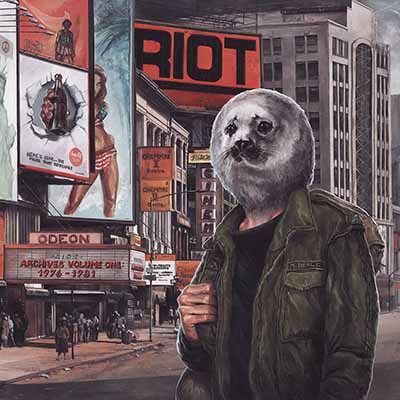 | ||||
| RIOT - Archives Volume 1: 1976-1981 DLP+DVD | |
HRR 553, ltd 1000, 150 x silver vinyl (HRR Mailoder exclusive), 450 x transparent blood-red vinyl + 400 x black vinyl, gatefold cover, bonus DVD "Live New York 1981" | |
| Side A: 01 Lovin Comes Easy 02 Sweet Sweet Felicia 03 Come Back to Me 04 In Every Way Side C: 10 49er 11 Kick Down the Wall 12 Narita 13 Here We Come Again | Side B: 05 I'm a Marshall 06 Teaser 07 I Don't Love You Anymore 08 Back on the Non-Stop 09 Waiting for the Taking Side D: 14 White Rock 15 Back on the Non-Stop (different) 16 Struck by Lightning 17 One Step Closer 18 Outlaw (Remixed + Edited) |
AVAILABLE | |
restored and mastered for vinyl by Patrick W. Engel at Temple of Disharmony
It’s almost impossible to overestimate the importance of Riot for the evolution of American heavy metal. The New Yorkers built the bridge between the first generation of hard rock and metal bands springing up in the early to mid-1970s (Blue Öyster Cult, Kiss and Van Halen) and the new wave carrying the torch in the late 1970s and early 1980s (led by Canadian proto speed metal merchants Anvil and Exciter).
Formed in New York City in 1975, Riot recorded one of the best heavy metal albums of all time: 1981’s »Fire Down Under«. However, before this landmark album finally saw the light of day, it took Riot six long years and two studio albums (1977’s »Rock City« and »Narita« from 1979) to get the formula right.
Although the main protagonists of Riot are no longer with us, singer Guy Speranza died on November 8th 2003 and main man Mark Reale, guitarist and principal songwriter, sadly passed away on January 25th 2012, it’s second guitarist L.A. Kouvaris who is an important first-hand witness.
His real name is Louis Antonios Kouvaris. Both his parents are Greek. Louis was born in Piraeus, Greece. His family moved to the United States when he was about three years old, Louis grew up in New York City. Before joining Riot in 1975, Kouvaris played in some local New York bands (e. g. Prism, Smoke and Harlequin). “When I joined, Riot was a basement band. They had just finished a three-song demo and did not have a deal at the time,” is how he describes his first encounter with the group. “I was called down to do an audition in May 1975. They had seen my resume at the musicians' referral service in Manhattan where I was in basically an office in a file cabinet with 10,000 other musicians but because my resume had the same influences as the Riot members they picked me for the audition at the time. My influences were Montrose, Rick Derringer, Michael Schenker, and a few others. Needless to say I got the audition. Mark and Guy called me the very next day and were excited about having me in the band as the other guitar player. This was after Phil Feit (bass) and Steve Costello (keyboardist). I had never met them and would never really know them until the late 2000s. I came in after it was decided that a keyboard was not the sound they envisioned for the future of the band. The line-up at the time was Jimmy Iommi (bass) and Peter Bittelli (drums) plus Mark Reale and Guy Speranza and myself, which became the original line-up that was to get the infamous »Rock City« deal.”
Riot had recorded four tracks for a proposed New York compilation album. The tape was taken to Midem in France, and all of a sudden a full-length Riot album was wanted … Louis Antonios Kouvaris explains: “The first album came about after the demo made some producers interested in the sound of the band. There was some interest in a compilation album being put out but the producers had plans of their own … The producers took the tape to Cannes in France for the Midem Music Convention and struck several publishing deals, which led them to put Riot on their label they created, which was Firesign Records. They then struck distribution deals with Victor Records in Japan, Attic Records in Canada and Ariola Records in Europe. The actual recording process of »Rock City« was a very quick one. The songs were rehearsed heavily and played out many many times in different clubs over Brooklyn, New York City and New Jersey, so going into the studio for the recording process was a breeze, it took very few takes ... and the overdubs were also done very quickly! The whole album only took about three to four weeks to record and was actually already finished in late 1976 but released in 1977.”
The songs “Rock City”, “Tokyo Rose” and of course “Warrior” are the key songs on Riot’s first album »Rock City«. These stood the test of time. Louis Kouvaris agrees: “’Rock City’, ‘Tokyo Rose’ and ‘Warrior’ are definitely the key songs on »Rock City« but one song that was really overlooked and should have taken off was ‘Overdrive’ … this song cranks and has a feverish finale. There is a pro video that was done in Brooklyn for our Japanese debut, which many have seen on youtube! When I did the tour in Japan with Riot V as their special guest we talked about how that song should have been in the repertoire, an outstanding kick-ass heavy song. I’m working on a project right now with Rick Ventura (Riot guitarist from 1978 to 1984) and we plan to do a very special show which will highlight early Riot tunes from the first three albums.”
»Rock City« also established the band’s infamous mascot: the seal. The album cover features, I am guessing, Stonehenge, a seal, an alien, an explosion and the skyline of New York City … Louis Kouvaris laughs: “The artwork for the »Rock City« album was kind of a fluke and was done by one of the producer’s family member, just randomly with no rhyme or reason. It consisted of the New York City skyline, there was a tire burning in the background in a weaved basket, a baby seal on a human body and a dead alien. The artwork was animated in the style of that time, but the mascot was later a staple on all albums to follow and promotional campaigns. The mascot was a complete random idea, a fluke for that matter.”
On the Riot »Archives Vol.1« album there are no less than 18 unreleased Riot tracks on there (including different mixes). Some of the studio/demo tracks like “Sweet Sweet Felicia”, “In Every Way”, “Come Back To Me”, “I’m A Marshall”, “Teaser” and “Loving Comes Easy” have never before seen the light of day. Second guitarist Louis Antonios Kouvaris was heavily involved in the whole songwriting process. However, in later years it was said that his writing style was too lightweight or “commercial” for Riot. Kouvaris does not understand this argument at all: “I’d like to clarify this accusation! I heard something in regard to the statement that I was too ‘commercial’. First of all, the songs I co-wrote were all picked because they were the same direction and sound and when played live couldn’t be any heavier and stronger. Take a song like ‘Tokyo Rose’ for example, it has a melodic intro with a heavy rock chorus. I was a main contributor on that tune and when I presented it, it was accepted by the band wholeheartedly. ‘Overdrive’ - lightweight? Commercial? I don’t think so! ‘Heart Of Fire’ lightweight, commercial? I think not! On the other hand, I had a conversation with my band mates and the producers and made a recommendation to write something commercially more accepted to have a successful hit and to make the band a commercial success without changing our sound or compromise it … like the the Scorpions and UFO. Their success was based on heavy rock melodic tunes with ballads to match. I was trying to make that point. Obviously, it was taken the wrong way. On the the »Rock City« album, there
was a tune called ‘This Is what I Get’, written by Guy and Mark. I liked the tune very
much and it was different from all the others, kind of an oddball song but I really liked it and it had a good hook. But that’s what I was talking about and
it appeared. Who doesn’t want a hit song and a shitload of money to go with
it? So saying all this … I can play all types of music and as a producer and recording engineer I can toggle between all kinds of music. I thought I always had a good ear for melody and songwriting in general, and at the time we tried to do what we thought was relevant. A good song is a good song! Commercial is
what people remember you by. I guess I was thinking ahead, or ahead of my
time. Cause if you look at later albums, when Rhett joined the band, it sounded like a lighter Bad Company type of sound, not as heavy as when I was in the band. And the next a albums, »Narita« and »Fire Down Under« … maybe I had a point ?”
In 1977, New York City was dominated by punk rock. How did it feel recording and putting out a heavy rock album like »Rock City«? Did it feel like going against the grain? How many other heavy rock bands were there in 1977 in New York City, apart from Kiss of course …? “When I joined the band in 1975, there was a tremendous amount of rock,” states Louis Kouvaris. “And it was great vocals, great songs, memorable ones, like Queen, Led Zeppelin, Bad Company, Boston, Montrose, Rick Derringer, Van Halen ... But there seemed to be a turn in the way music was going. The rock type of music was on top for a long time, but this was soon to change. In popularity the disco scene became enormous and punk started to kick its head in the later 1970s. The very few rock bands who were new were having a difficult time getting record deals because of the evolution of the music scene. Even I started doing things like some session work for Jacque Moralli and the Village People, heavy solo guitar playing was popular in a lot of those tunes. Rock seemed like it was now taking a backseat, the only bands that were surviving were bands like Van Halen and Boston. It was disheartening to say the least. »Rock City« had just come out prior to the upcoming change of the music scene. It felt good at the time but yes, it started to feel like an uphill battle for a new band. Even though we were very popular in Japan, we never made it there until much later.”
Nevertheless, Riot manged to open up for some great acts: Journey, Neil Young, Tom Petty, Rick Derringer, The Outlaws, Southside Johnny and The Godz, to name just a few.
Louis Kovaris started recording the 1979 »Narita« album as a second guitarist for Riot but left during the recordings. What had happened? “I started the recording of »Narita« in the spring summer of 1978,” he confirms. “Mark and I had written quite a few new tunes for that album, which we were playing live and tweaking them when we got to the studio. I recorded ‘49er’, which I was the main writer and the song Mark and I worked heavily on. But in between the recordings, we were gigging and in August of 1978 we had a tour with Journey coming up. When it ended and we were ready to go back into the studio, the following day I got a phone call from the producers saying that my services were no longer needed. I never got a real answer why … it was the last time that I would speak to Mark. Later on in the early 1980s, I did reach out to Guy Speranza and Jimmy Iommi to have dinner with our ladies. We discussed that day and they said it was management and that they were shocked and surprised, being that everything was going so well. They said they loved playing with me but there were changes they weren’t aware of. Even though I wasn’t satisfied with the explanation, I knew that they only knew what they were told. Mark had never reached out again and I never bothered calling him. I considered Mark a close friend but he had his issues … he had the hand of the producers guiding him, so I left it alone. August of 1978 was my end with Riot.”
How would Louis Kouvaris, in retrospect, describe the group dynamics in Riot: Were Mark Reale and Guy Speranza leading the band from the front? His answer is honest: “Looking back, Mark and Guy were leading the band musically but they didn’t have any control of what was going to get out there or had any say whatsoever. The producers had the band lock, stock and barrel in everything they did, even though Steve Loeb said In the documentary part 2 »Fight Or Fall« that he made Mark look like he was making all the decisions. But I know for a fact that that’s not true! There was always talk of how screwed up everything was, even after I left … Loeb even said in the documentary that there was never any money made on any record. Then I ask you why the hell would you go on and make seven more albums with a band that doesn’t make you any money? Please answer that question! Why would you take risk after risk? Talk about being in jail … Riot was handcuffed and bound without any way to escape, and it took the band 20 years to escape from Steve Loeb. The only way they were able to escape was that Mark had to relinquish all his publishing rights to all the songs and all he had done in the past 20 years. Does that sound like he had any control? I don’t think so … you be the judge. Maybe somebody should ask the real questions. If f there was so much harmony, why would so many members quit and why are there so many members? I believe that Mark had no control over his musical life whatsoever. The only thing he had was that he was able to write some great music and play what he thought was relevant at the time. I don’t know if Mark was happy but I’ll let you be the judge, the poor guy died broke and living with his dad some of the time …”
How was it for Louis Kouvaris working alongside Mark Reale as a second guitarist? Did it gel? Was there a clear distinction of who was the lead guitarist and who was responsible for the solos or was this not set in stone? “Mark and I worked very well together and we never had issues with who would play what,” states Kouvaris. “Songwriting was actually a good process for us, especially with creating double harmony guitars parts, which we loved doing because of how beautiful the melodies sounded. Even working on all the songs and tweaking them little by little and to get them exactly the way we wanted them to sound. We were more interested in playing the the songs as best as we could. Solos were never an issue, we shared equally and when we played live, it showed. We had a little competitiveness but in a healthy way ... no one will deny this, there was never one who was the lead guitarist because we didn’t have the big egos. We actually enjoyed playing together. What happened towards the end of my time in the band is a mystery, but in a way they did me a favor because what was to follow was a tragedy. I believe if we never signed with Firesign, I know the life of Riot would have had a better direction. I was against signing the contract from the beginning but being young and naive I went along with Mark’s decision, even though we all knew it was wrong. We just wanted to play music. Very poor decision making was the reason Riot had so many problems. Ask any member! Mark was trusting at the time and maybe he just
didn’t know any better ...”
“After I left Riot, I never really followed the direction of the band”, closes Louis Antonios Kouvaris. “I had heard of many changes through various channels but it wasn’t until much later when I was looking for the »Rock City« album in a local record store chain and found the »Privilege Of Power« album. When I heard it, I was amazed at the direction that Mark took, his musical style had changed quite a lot, a departure from what I remember. In 2015, I got a call from Mike Flyntz to come and do a guest appearance in Brooklyn with Riot V. I was very flattered by Mike’s call and I got the opportunity to meet Todd Michael Hall, Donnie Van Stavern, Nick Lee and Frank Gilchrist. Since then I’ve appeared in Japan and then in Greece. In January of 2018, Riot was inducted into the ‘Hall Of Heavy Metal History’, an honor a long time in the making. I have a project in the works with Rick Ventura and myself, to be disclosed at a future date. Thank you Riot V for carrying the torch and continuing the saga of some of the most incredible music ever written. Good luck with the new album, my friends.”
Matthias Mader
